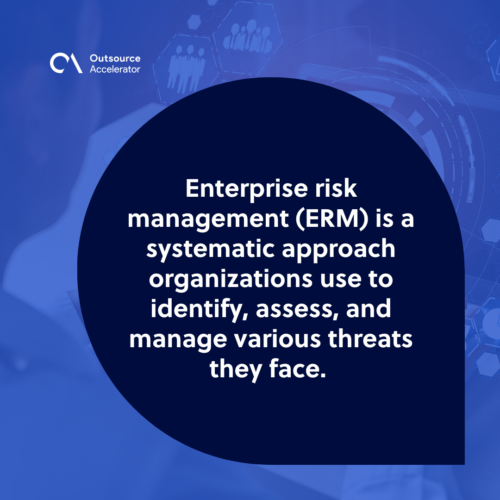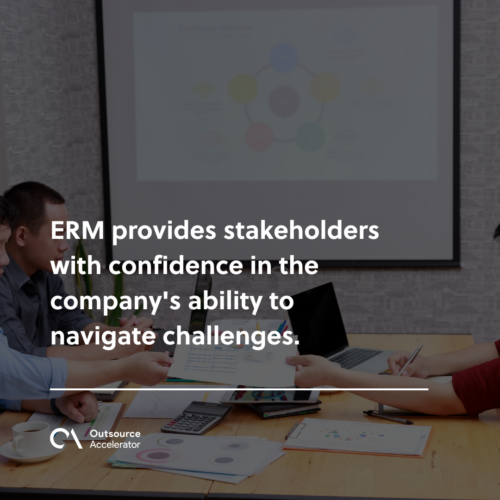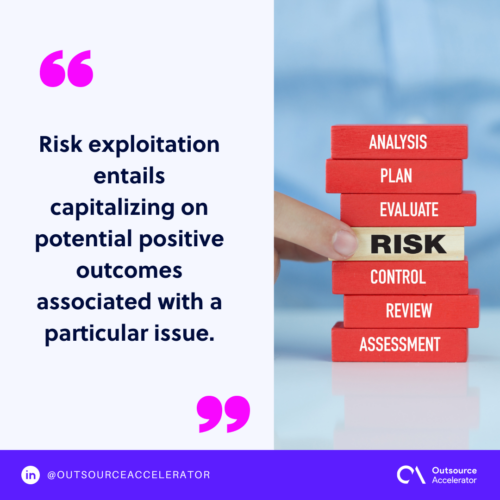A comprehensive guide to enterprise risk management (ERM)

In this day and age, companies must operate in a constantly changing environment. They need to navigate an array of risks that can threaten their operations.
One way that firms can manage these threats is through enterprise risk management (ERM). It offers a comprehensive way to manage and mitigate risks that can jeopardize a business’ future.
Data from Gitnux reveals that 76% of companies have or plan to carry out an ERM program. This shows that organizations recognize the value of an enterprise risk management plan.
Let’s take a closer look at enterprise risk management, its key objectives, and the threats it addresses. We’ll also explore ERM’s pros, cons, and core components to understand its significance.
What is enterprise risk management (ERM)?
Enterprise risk management (ERM) is a systematic approach organizations use to identify, assess, and manage various threats they face.
This proactive process aims to provide a holistic view of risks and their potential impact on the achievement of goals and objectives.
ERM allows businesses to establish procedures for risk management in their everyday operations.
By creating a risk-aware culture across an organization, ERM helps address issues before they become critical. This ensures that the company is better prepared to navigate future uncertainties.

Core objectives of enterprise risk management
Implementing a robust enterprise risk management process is crucial for businesses as it allows them to manage risks and seize opportunities proactively.
Enterprise risk management focuses on achieving several core objectives, which include:
Identifying risk
The objective of ERM is to identify all relevant and potential dangers. It looks for threats that may affect operations and the achievement of goals and objectives.
This involves a thorough review of internal and external factors that could impact the organization.
Assessing risk
After identifying the potential threats, the next objective of ERM is to assess them. This includes determining the potential impact of a risk on the company.
Risks can then be prioritized based on the level of hazard they present. Firms can then allocate appropriate resources for mitigation.
Managing risk
The third core objective of ERM is the development of a strategic plan, which involves managing risks using an informed decision-making process.
Handling these dangers includes selecting the most appropriate risk response strategy, assigning responsibilities, and developing action plans.
Monitoring risk
Finally, ERM includes an ongoing monitoring process to mitigate the effects of risks. This encompasses gathering relevant data to track the progress of risk management efforts.
Monitoring risks also verifies actions to mitigate risks and address the threats as anticipated.
Types of risks addressed by enterprise risk management
Enterprise risk management focuses on addressing a wide range of significant risks that can impact the organization’s objectives and operations.
An ERM is designed to address a wide range of threats that businesses face, including the following:
Compliance risks
Compliance risks refer to the potential for legal or regulatory sanctions, financial loss, or reputational damage. These may result from non-compliance with laws, regulations, or industry standards.
Legal risks
This kind of risk involves threats of legal proceedings against the company. Legal risks include lawsuits, fines, and judgments.
Strategic risks
Strategic risks are linked to decisions and actions that may impact achieving planned objectives.
These threats may include market changes, competitive pressures, or ineffective strategic planning.
Operational risks
Operational risks arise from internal issues or external events. These may end in loss due to human error, technology failures, supply chain disruptions, or natural disasters.
Security risks
Security risks cover damage, loss, or impact to security systems and information assets. They may stem from both internal and external threats, such as cyber-attacks or data breaches.
Financial risks
This pertains to potential adverse impacts on financial stability, liquidity, or profitability.
Financial threats include market volatility, credit defaults, foreign exchange fluctuations, or inadequate financial controls.
Advantages of enterprise risk management
Implementing an effective enterprise risk management strategy offers several benefits, including:
- Improved decision-making. ERM provides decision-makers with comprehensive risk information. This allows them to make informed choices and allocate resources more effectively.
- Reduced costs. Enterprise risk management programs help identify and mitigate potential hazards before they occur. When managed correctly, this can result in reduced costs linked with risk events.
- Enhanced resilience. ERM helps organizations proactively identify and manage risks. This reduces the likelihood of unexpected disruptions and enhances adaptability to changing circumstances.
- Optimized resource allocation. Enterprise risk management assists in classifying threats and dividing resources accordingly. It ensures that resources are allocated where risks have the most significant possible impact.
- Stakeholder confidence. ERM demonstrates a commitment to risk management. In turn, it provides stakeholders with confidence in the company’s ability to navigate challenges.

Disadvantages of enterprise risk management
Enterprise risk management may offer numerous benefits. But there are also potential challenges to consider:
- Resource-intensive. Implementing ERM requires significant effort, coordination, and resources. Organizations may face challenges integrating and maintaining enterprise risk management practices across departments.
- Risk aversion. Overemphasis on risk mitigation may lead to excessive caution and missed opportunities for innovation and growth. It is essential to strike a balance between risk mitigation and organizational agility.
- Limited predictive accuracy. Despite comprehensive risk assessment, it is challenging to predict all potential threats accurately. Unforeseen events or rapidly evolving risks may pose challenges to even the most robust ERM frameworks.
- Resistance to change. Enterprise risk management programs may be difficult to implement. That’s because they require changes to company culture and processes.
- Over-reliance on ERM. There is a chance businesses may over-rely on the enterprise risk management program. This leads to a lack of attention to other critical business areas.
Key components of an ERM plan
Understanding the most significant risks facing the organization is crucial among these components.
An effective enterprise risk management plan has the following key components that create a comprehensive framework:
Internal environment
The internal environment encompasses an organization’s:
- Culture
- Values
- Policies
- Procedures
- Risk appetite
- It involves relaying risk management processes to participants and supports allocating needed resources.
The internal environment also includes leadership commitment, governance structures, and risk management philosophy.
Objective setting
Objective setting defines the organization’s goals and aligns them with risk management strategies.
Clear objectives let businesses identify threats that could impede goal achievement. They can then develop appropriate risk response plans.
Event identification
Event identification systematically identifies possible events that could affect the company’s ability to achieve its objectives. This includes internal and external events that may pose risks or opportunities.
Risk assessment
Risk assessment evaluates the likelihood and impact of identified direct and residual risks.
An example of a direct risk would be a brand having reputational damage due to non-compliance with laws. The residual risk would then be its employees wanting to distance themselves from the brand by resigning.
Assessing risks helps prioritize them based on their significance, allowing organizations to allocate resources effectively for mitigation.

Risk response
Risk response focuses on developing and implementing strategies to address identified hazards.
Organizations can respond to risks in the following ways:
- Avoidance. This strategy aims to eliminate or avoid risks entirely. Organizations opt for this when the possible negative impact outweighs any potential benefits.
- Mitigation. Risk mitigation focuses on reducing the possibility or impact of a risk. It implements controls, safeguards, or countermeasures to minimize adverse consequences.
- Transfer. Risk transfer shifts the risk to another party through insurance, contracts, or outsourcing. By doing so, companies pass on the financial burden and responsibility to a third party.
- Acceptance. Businesses choose to accept certain risks when the potential impact is low, or the cost of mitigation is too high. Acceptance involves acknowledging and managing these risks within acceptable tolerance levels rather than ignoring them.
- Exploitation. Sometimes, firms identify opportunities within risks. Risk exploitation entails capitalizing on potential positive outcomes associated with a particular issue.
Control activities
Control activities carry out procedures to mitigate risks and ensure effective risk management. These controls include segregation of duties, security measures, and internal policies and procedures.
Also called internal controls, they are broken into two types:
- Preventative controls. These are proactive measures put in place to prevent risks from happening. They aim to eliminate or minimize the likelihood of negative events.
- Detective controls. They are implemented to identify risks or issues that have already occurred. These help detect problems that may have bypassed preventative measures.
Information and communication
Information and communication involve collecting, analyzing, and disseminating risk-related information.
Effective communication ensures that stakeholders are well-informed about risks and ERM strategies.
Monitoring
Monitoring is the ongoing evaluation and review of the effectiveness of enterprise risk management activities. Regular monitoring ensures ERM practices align with organizational objectives and adapt to changing threats.
Enterprise risk management framework
An enterprise management framework provides a structured approach to applying ERM practices.
Contrasting with traditional risk management approaches that often focus on individual risks in isolation, an ERM framework adopts a holistic viewpoint.
There are many established ERM frameworks that can be referenced. But here’s the gist of what it can include:
- Establish risk context. Businesses must develop an internal context for risk management. This involves defining the scope, key stakeholders, risk objectives, and appetite.
- Identify potential risks. Organizations must identify internal and external risks that might impact their operations.
- Risk assessment. The probability and potential impact must be assessed to identify key threats.
- Risk response and decision-making. Risk response strategies are implemented to achieve optimal outcomes.
- Ongoing monitoring. Regular monitoring should be conducted to determine the effectiveness of risk response strategies.







 Independent
Independent




